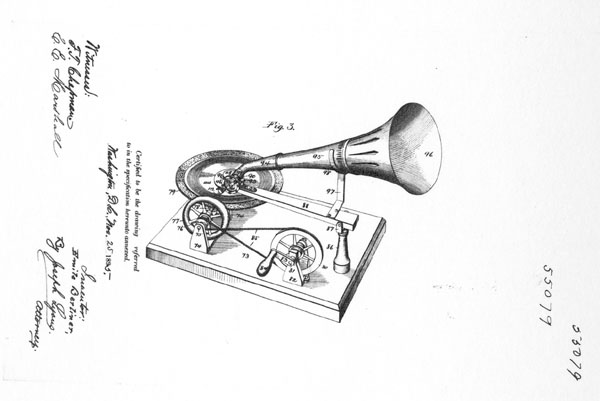 In 1889, a German immigrant to the U.S. named Emile Berliner introduced a commercial version of the record player he had been developing since about 1887. By 1894, it was for sale in the US as we.. The player used a disk instead of a cylinder (although Edison, Tainter, Cros, and others had anticipated the use of the disk). The recording was made on a zinc disk coated with wax. Once a recording was carved into the wax, the disk was dipped in an acid solution, which ate away the zinc under the groove and etched a groove into the metal survace. Then, using an electroplating process, the zinc disk was turned into a stamper that could be used to produce the final recordings in large numbers by pressing the stamper into a ball of semi-solid “Vulcanite,” (a type of rubber) which then hardened. He called it the Gramophone.
In 1889, a German immigrant to the U.S. named Emile Berliner introduced a commercial version of the record player he had been developing since about 1887. By 1894, it was for sale in the US as we.. The player used a disk instead of a cylinder (although Edison, Tainter, Cros, and others had anticipated the use of the disk). The recording was made on a zinc disk coated with wax. Once a recording was carved into the wax, the disk was dipped in an acid solution, which ate away the zinc under the groove and etched a groove into the metal survace. Then, using an electroplating process, the zinc disk was turned into a stamper that could be used to produce the final recordings in large numbers by pressing the stamper into a ball of semi-solid “Vulcanite,” (a type of rubber) which then hardened. He called it the Gramophone.
The recording process for making a Graphophone record was different enough from the ones used to make Phonographs or Gramophones that it was patentable, which gave Berliner an entry into the marketplace. And while some contemporary listeners thought his disks sounded worse than cylinders, the disk could more readily be mass-produced. An important feature of both the Phonograph and the Graphophone was gone, however – the ability of the consumer to make a home recording. As more and more consumers chose to buy commercial entertainment recordings, this began to seem like much less of a disadvantage.
Beside the advantages of mass production, gramophone records could also produce a higher sound volume than the phonograph or graphophone records of the day. That’s because the volume of a record was directly related to how hard the playback stylus was pressed into the groove–the harder the machine pressed, the more sound came out, but at some point the pressure damaged the recording. The designs of records and record players reflected this trade-off between volume and the durability of records. For a few years at least, before the phonograph was improved, the Berliner disk could produce a louder, room-filling sound, and this became another selling point. T